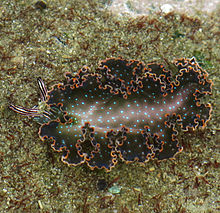| Elysia diomedea | |
|---|---|

| |
| Scientific classification | |
| Domain: | Eukaryota |
| Kingdom: | Animalia |
| Phylum: | Mollusca |
| Class: | Gastropoda |
| Family: | Plakobranchidae |
| Genus: | Elysia |
| Species: | E. diomedea |
| Binomial name | |
| Elysia diomedea (Bergh, 1894) | |
| Synonyms | |
| |
Elysia diomedea is a species of sea slug found throughout the Pacific coast of Central America.
This sea slug resembles a nudibranch but is not closely related to that order of gastropods, instead belonging to a closely related clade, Sacoglossa, the "sap-sucking" sea slugs.
Description
Elysia diomedea grows to a length of about 50 millimetres (2.0 in). It is a pale green colour with longitudinal streaks of white. The parapodia are densely convoluted and edged with orange and black. They are not joined at the front and when they are spread apart, they reveal blue spots underneath. Parts of the gut ramify into the foot, causing green patches which are interspersed with translucent white streaks. The rhinophores have longitudinal stripes of yellow and black.
Distribution
Elysia diomedea is found in the eastern Pacific Ocean off the coasts of Central America including the Gulf of Panama and the Gulf of California, where it is common. It lives at depths of up to 20 metres (66 ft).
Biology
Elysia diomedea exhibits kleptoplasty in the same way as do the closely related Elysia clarki and Elysia crispata. When it feeds on algae, some of the chloroplasts that it has ingested remain in its tissues. It then makes use of the energy they produce as they continue to photosynthesize. To maximise this, the slug is often seen in sunlit shallow waters, spreading its parapodia.
Elysia diomedea deposits its eggs in an "egg ribbon" which forms a flat spiral. The eggs are very tiny, which suggests that they pass through a veliger larval stage as part of the zooplankton before settling on the seabed, undergoing metamorphosis and becoming juvenile crawling slugs.
References
- Bouchet, P. (2014). Elysia diomedea (Bergh, 1894). Accessed through: World Register of Marine Species at http://www.marinespecies.org/aphia.php?p=taxdetails&id=494440 on 2014-11-08
- ^ Elysia diomedea (Bergh, 1894) The Sea Slug Forum. Retrieved 2012-01-24.
- ^ Elysia diomedea The Slug Site. Retrieved 2012-01-24.
- Larval development The Sea Slug Forum. Retrieved 2012-01-24.
- Jensen K.R. (2007) Biogeography of the Sacoglossa (Mollusca, Opisthobranchia). Bonner Zoologische Beiträge 55:255–281.
External links
- Photos of Elysia diomedea on Sealife Collection
| Taxon identifiers | |
|---|---|
| Elysia diomedea | |